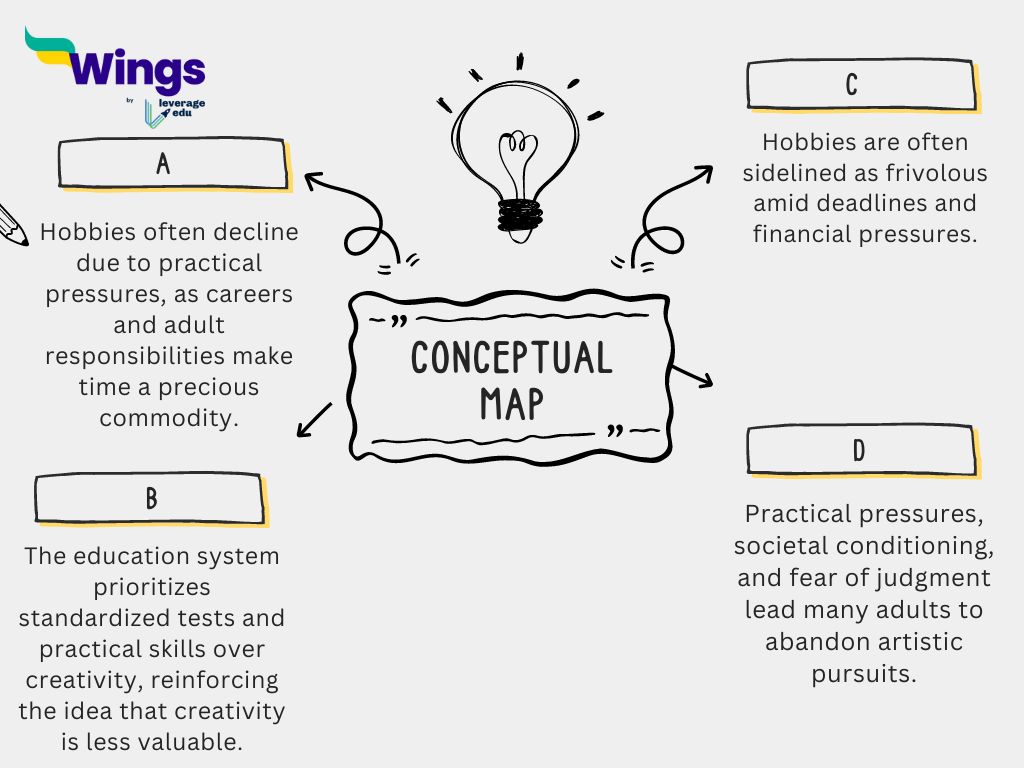Brainstorming Ideas
Refer to the following brainstorming ideas to get a solid understanding of the answer.
- One significant factor for the decline of pursuing hobbies is the pressure of practicality. As we navigate the complexities of careers and adult responsibilities, time becomes a precious commodity.
- Hobbies are often relegated to the periphery, deemed frivolous in the face of deadlines and financial burdens.
- The education system often prioritizes standardized tests and practical skills over creative exploration. This reinforces the notion that creativity is less valuable than more quantifiable pursuits.
- The decline in artistic engagement among adults is a result of a confluence of factors. The pressure to be practical, coupled with societal conditioning and the fear of judgment, can lead adults to abandon their creative pursuits.

Q. Many people have a variety of hobbies when they are young, but then stop when they become adults. Why do so many adults stop engaging in creative and artistic pursuits?
Ans. Childhood is a vibrant tapestry woven with artistic exploration. From finger painting to building Lego castles, young minds revel in the freedom to create. Yet, as we transition into adulthood, a curious phenomenon occurs – many abandon these creative pursuits altogether. This essay explores the reasons behind this decline in artistic engagement among adults.
One significant factor is the pressure of practicality. As we navigate the complexities of careers and adult responsibilities, time becomes a precious commodity. Hobbies are often relegated to the periphery, deemed frivolous in the face of deadlines and financial burdens. This focus on practicality can stifle the inherent creativity that resides within us. Artistic endeavours, once seen as a source of joy and self-expression, become viewed as a luxury we can’t afford.
Furthermore, societal conditioning can play a role. The education system often prioritizes standardized tests and practical skills over creative exploration. This reinforces the notion that creativity is less valuable than more quantifiable pursuits. Additionally, the fear of judgment can be a powerful deterrent. Adults, unlike children, are often self-conscious about their artistic abilities. The worry of not being “good enough” can prevent them from even attempting to create, effectively shutting the door on artistic exploration.
In conclusion, the decline in artistic engagement among adults is a result of a confluence of factors. The pressure to be practical, coupled with societal conditioning and the fear of judgment, can lead adults to abandon their creative pursuits. However, it’s important to remember that creativity is not a childhood relic. Reconnecting with our artistic side can bring joy, reduce stress, and even enhance problem-solving skills. So, dust off those metaphorical crayons and embrace the inherent creativity that lies within – regardless of age.
Analysis
Paraphrased Statement: Childhood is a vibrant tapestry woven with artistic exploration. Young minds revel in the freedom to create.
Thesis Statement: As we transition into adulthood, many abandon their creative pursuits altogether due to the burden of practicality.
Body Paragraph 1-Topic Sentences: One significant factor for people abandoning their creative pursuits is the pressure of practicality
Body Paragraph 1- Supporting Reasons and Explanations: As we navigate the complexities of careers and adult responsibilities, time becomes a precious commodity. Hobbies are often relegated to the periphery, deemed frivolous in the face of deadlines and financial burdens. This focus on practicality can stifle the inherent creativity that resides within us.
Body Paragraph 2- Topic sentence: Societal conditioning can play a role in the decline of creative pursuits among young adults.
Body paragraph 2- Supporting Reasons and Explanations: The education system often prioritizes standardized tests and practical skills over creative exploration. This reinforces the notion that creativity is less valuable than more quantifiable pursuits. Additionally, the fear of judgment can be a powerful deterrent.
Conclusion: In conclusion, the decline in artistic engagement among adults is a result of a confluence of factors. The pressure to be practical, coupled with societal conditioning and the fear of judgment, can lead adults to abandon their creative pursuits.
Vocabulary in Use
| Word | Meanings |
| Tapestry | A piece of cloth with a pattern or picture. |
| Relegated | Downgrade |
| Frivolous | Not having any serious purpose or value |
| Stifle | Suffocate |
| Deterrent | Hindrance |
Connectors and Linkers
- Furthermore
- Additionally
- In conclusion
Are you preparing for the PTE Exam? Check out the blogs below to bolster your chances of securing better scores in the PTE exam.
Download the Leverage App today.


Need help preparing for PTE? Check out the best PTE preparation courses in the market offered in a live training environment by trusted educators. If you want to help studying abroad, call 1800572130.
 One app for all your study abroad needs
One app for all your study abroad needs















 60,000+ students trusted us with their dreams. Take the first step today!
60,000+ students trusted us with their dreams. Take the first step today!